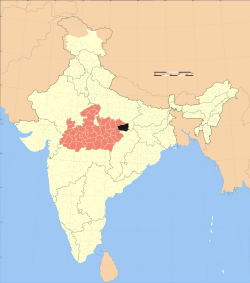Sidhi District
|
Sidhi district सीधी जिला |
|
|---|---|
| District of Madhya Pradesh | |
 Location of Sidhi district in Madhya Pradesh |
|
| Country | India |
| State | Madhya Pradesh |
| Administrative division | Rewa |
| Headquarters | Sidhi |
| Government | |
| • Lok Sabha constituencies | Sidhi |
| Area | |
| • Total | 10,536 km2 (4,068 sq mi) |
| Population (2011) | |
| • Total | 1,126,515 |
| • Density | 110/km2 (280/sq mi) |
| Demographics | |
| • Literacy | 66.09 per cent |
| • Sex ratio | 952 |
| Major highways | NH-7 |
| Average annual precipitation | normal mm |
| Website | Official website |
Sidhi District is one of the tribal districts of Madhya Pradesh state of India. The town of Sidhi is the district headquarters. The district is part of Rewa Division.
Sidhi is a part of Madhya Pradesh, an image of proud history and culture. It forms the northeastern boundary of the state. Sidhi is well known for its natural beauty, historical importance and rich cultural roots. Sidhi possesses abundant natural resources with the river Sone draining the district, and with coal deposits which feed major industries across the country. This is the birth place of Birbal.There are many historical and beautiful places here that show that this is a unique combination of natural beauty. Here is the Sanjay Tiger Reserve or Sanjay National Park which tells the magnificence of the Lions here.There is a beautiful park Parasli.
Sidhi district comprises seven tehsils: Bahari, Churhat, Gopad Banas, Rampur Naikin, Majhauli, Kusmi and Sihawal. There are four Madhya Pradesh Vidhan Sabha constituencies in this district, namely, Churhat, Sidhi, Sihawal and Dhauhani. All of these are part of Sidhi Lok Sabha constituency.
The Vindhyachal Super Thermal Power Station supplies electricity over a wide area. On one side the spectrum of its floristic socio-cultural diversity and ethnic history of tribal, the district has a panoramic view of the Kaimur, Kehejua and Ranimunda hills blazing with flowers of flame of forest and intoxicated by the sweet smell of mahua flowers. The whole of Sidhi district was part of Rewa state.
In 2006 the Ministry of Panchayati Raj named Chamba one of the country's 250 most backward districts (out of a total of 640). It is one of the 24 districts in Madhya Pradesh currently receiving funds from the Backward Regions Grant Fund Programme (BRGF).
...
Wikipedia
